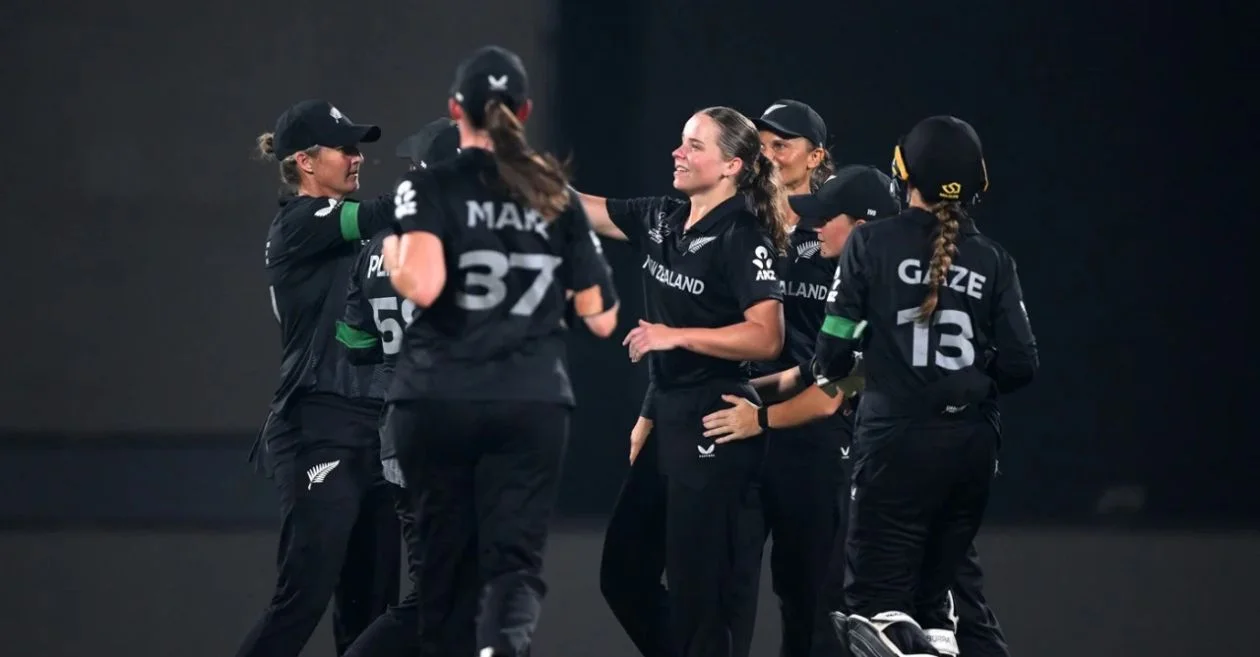The ICC Women’s World Cup 2025 witnessed a spirited revival from New Zealand Women, who stormed back into contention with a commanding 100-run victory over Bangladesh Women at the Barsapara Cricket Stadium in Guwahati. After enduring a disappointing start to their campaign, the White Ferns showcased a complete team performance, blending batting grit, bowling precision, and fielding excellence to register their first win of the tournament.
It was a day of redemption for Brooke Halliday, a show of leadership from Sophie Devine, and a statement of dominance from the Kerr sisters and Lea Tahuhu, as New Zealand dismantled Bangladesh’s resistance with professional precision.
A Must-Win Situation: White Ferns Rise Under Pressure
Coming into the contest, New Zealand were under immense pressure. Two back-to-back defeats had left them desperate for a win to keep their semifinal hopes alive. Bangladesh, meanwhile, had shown fighting spirit despite being winless, and their spinners were expected to trouble New Zealand’s batting order on the dry Guwahati surface.
Winning the toss, Sophie Devine chose to bat first — a decision rooted in confidence and strategy. Her team needed runs on the board, and despite early wobbles, New Zealand built a total that would eventually prove far beyond Bangladesh’s reach.
Early Wickets Shake the White Ferns
Bangladesh began the match with purpose. The opening overs from Marufa Akter and Rabeya Khan were tight and probing, testing the patience of New Zealand’s top order.
It didn’t take long for Bangladesh to strike. Bernadine Bezuidenhout was the first to fall, caught behind for just 8, trying to cut a ball that wasn’t quite short enough. Soon after, Suzie Bates—the experienced campaigner and one of the most prolific batters in women’s cricket—departed cheaply for 12, trapped in front by Rabeya’s flighted delivery.
At 38/3, when Amelia Kerr was undone by a delivery that turned sharply past her inside edge, New Zealand’s dressing room must have felt a sense of déjà vu from their earlier losses. But from that point on, the game began to turn in the White Ferns’ favour — thanks to a mature and composed partnership.
Brooke Halliday and Sophie Devine Lead the Fightback
With the innings wobbling, Brooke Halliday and Sophie Devine joined forces in what would become the defining partnership of the match. Both players approached their innings with patience and intelligence, aware that a collapse could prove costly.
Halliday, who has often played the role of the unsung anchor, showed exemplary temperament. Her 69 off 104 balls was not the flashiest of innings, but it was built on discipline and awareness. She worked the gaps beautifully, rotated the strike effectively, and punished loose deliveries with elegant timing through the covers and square leg.
At the other end, Sophie Devine, the skipper, combined composure with controlled aggression. Her 63 from 85 balls featured crisp boundaries, especially against the seamers, and her ability to absorb pressure allowed Halliday to settle in.
Together, they stitched a 112-run partnership for the fourth wicket, rebuilding the innings from the brink and guiding New Zealand to a position of control. Their stand not only steadied the ship but also sapped the momentum out of Bangladesh’s attack.
Late Flourish Helps New Zealand Reach 227/9
After Halliday fell to Rabeya Khan, who continued her impressive spell to finish with 3/30, Bangladesh briefly clawed back into the contest. The lower middle order, however, ensured that New Zealand didn’t lose all the momentum.
Maddy Green’s 25 off 32 balls provided a mini boost, and Lea Tahuhu’s cameo of 12 not out off just 4 balls — including a powerful strike over mid-wicket — helped push the total to a competitive 227/9.
Given the slowness of the pitch and New Zealand’s experienced bowling attack, this total looked far more formidable than it appeared on paper.
Bangladesh’s Chase Falters Early
Bangladesh’s reply began on the wrong note. Rosemary Mair struck in her first over, removing opener Murshida Khatun with an in-swinger that clipped the top of off stump — a perfect start for New Zealand.
From there, the White Ferns’ bowlers hunted in packs. Jess Kerr, with her smooth action and impeccable line and length, tore through the middle order, returning figures of 3/21. She used subtle variations in pace and seam movement to exploit Bangladesh’s technical flaws.
Her sister, Amelia Kerr, complemented her beautifully from the other end. Bowling with flight and control, she gave nothing away. Her dismissal of Nigar Sultana, Bangladesh’s captain and most dependable batter, was a crucial blow. Nigar tried to loft Amelia over the infield but only managed to find Devine at mid-off.
With Nigar’s wicket, Bangladesh slumped to 33/6, their hopes of chasing 228 evaporating rapidly.
Lea Tahuhu’s Raw Pace and Experience Seal the Deal
As Bangladesh’s lower order tried to hold on, Lea Tahuhu returned to the attack and ensured there would be no late heroics. Her experience shone through as she mixed short deliveries with sharp seamers aimed at the stumps.
Tahuhu finished with 3/22, including the crucial wicket of Fahima Khatun, who top-scored for Bangladesh with 34. Fahima’s resistance, along with Rabeya Khan’s gritty 25, helped Bangladesh avoid complete embarrassment, pushing the total past 100.
But the writing was on the wall. Bangladesh were eventually bowled out for 127 in 39.5 overs, giving New Zealand a thumping 100-run win — a result that reignited their World Cup campaign.
Brooke Halliday Named Player of the Match
There was little doubt about the Player of the Match. Brooke Halliday’s measured 69 anchored New Zealand’s innings at a time when they were teetering. Her knock exemplified calmness under pressure and laid the foundation for the eventual victory.
Speaking after the game, Halliday said:
“It was about sticking to basics and trusting our process. The partnership with Sophie was crucial — we just focused on taking it over by over. The bowlers were outstanding, and it feels great to get that first win on the board.”
Her words reflected the renewed confidence in the New Zealand camp — a side that now looked determined to climb the points table.
A Clinical Bowling Display Reflects Team Character
What stood out about New Zealand’s bowling was the discipline and unity. Every bowler stuck to their role — from Mair’s early breakthrough to the Kerr sisters’ accuracy and Tahuhu’s closing punch.
Amelia Kerr’s control in the middle overs was especially impressive. She bowled ten overs for just 23 runs, consistently building pressure and forcing Bangladesh’s batters into mistakes.
The fielding, too, was sharp — something the White Ferns had been criticized for earlier in the tournament. Diving stops, clean catches, and quick relays were all signs of a team back in sync.
Bangladesh Struggle with Inexperience and Pressure
For Bangladesh, the defeat was a harsh reminder of the gap between potential and execution. Their bowlers had moments of brilliance — particularly Rabeya Khan, who was outstanding with both flight and control — but their batting continues to be the Achilles’ heel.
Bangladesh’s inability to handle pace and movement exposed their inexperience at the highest level. Captain Nigar Sultana admitted as much, saying:
“We need to bat with more intent and confidence. Our bowlers are doing well, but we can’t expect them to win matches if we don’t put runs on the board.”
Despite the setback, Bangladesh have shown glimpses of progress — their spinners remain effective, and players like Fahima Khatun continue to fight till the end.
The Turning Point: Halliday and Devine’s Partnership
Cricket often turns on moments of composure, and the 112-run partnership between Halliday and Devine was exactly that. When New Zealand were reeling at 38/3, Bangladesh looked poised to run through their lineup. But that stand shifted momentum completely.
It allowed New Zealand to play freely in the later stages and gave their bowlers a defendable target. The mental shift that partnership provided could prove invaluable for the White Ferns as they approach tougher matches ahead.
Looking Ahead: Momentum Restored for New Zealand
With this win, New Zealand not only collected their first points but also gave their net run rate a major boost. Their comprehensive margin of victory has lifted spirits and restored belief in a side that looked out of rhythm just days earlier.
Next up, the White Ferns will face South Africa, a match that could determine their semifinal hopes. If they replicate the balance and discipline shown against Bangladesh, they will be a difficult side to beat.
Bangladesh, on the other hand, will need to regroup quickly before facing Pakistan. Their batting will be under scrutiny, and finding a way to counter pace and spin will be key if they want to avoid finishing at the bottom of the table.
A Statement Win for the White Ferns
The 100-run victory at Guwahati wasn’t just a scoreline — it was a statement of resilience and revival. After two early losses, New Zealand responded with the kind of professionalism that has long defined their cricket.
Brooke Halliday’s calm innings, Sophie Devine’s leadership, and the combined brilliance of Jess Kerr, Amelia Kerr, and Lea Tahuhu made this a complete team effort. More importantly, it reminded the world why New Zealand remains one of the most respected sides in women’s cricket — adaptable, disciplined, and never short of fight.
As the tournament progresses, this match could well be remembered as the turning point that reignited their campaign and reminded everyone that the White Ferns, when cornered, are capable of roaring back stronger than ever.
Please check for information on the best betting sites in India – https://selectory.org/best-betting-sites/















